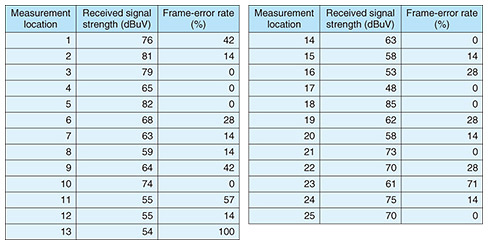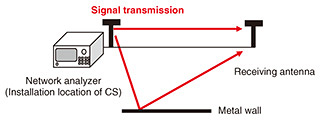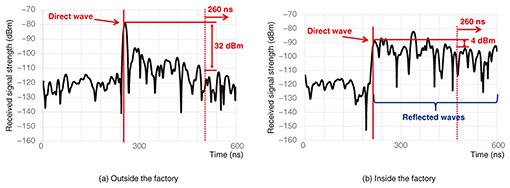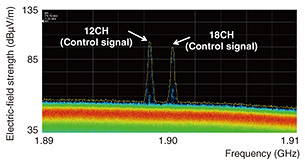 |
|||||
|
|
|||||
|
Practical Field Information about Telecommunication Technologies Vol. 23, No. 2, pp. 30–34, Feb. 2025. https://doi.org/10.53829/ntr202502pf1 Case Study of Voice Interruption Involving Cordless Telephones Caused by Reflected Waves Due to Installation EnvironmentAbstractThis article presents a case study in which voice calls on cordless telephones of a business-phone system used in an environment, such as a factory where reflected waves occur, were interrupted. This is the eighty-sixth article in a series on telecommunication technologies. Keywords: cordless telephone, reflected wave, voice interruption 1. IntroductionThe Technical Assistance and Support Center (TASC), NTT EAST investigates difficult-to-solve telecommunication problems at customer premises and proposes countermeasures against them. A business-phone system, which is used in offices and factories, generally consists of the master-equipment unit and several dozen telephones. Telephones used for business-phone systems are available as two types: (i) corded telephones, where the handset is connected to the base unit by wires, and (ii) cordless telephones, where the handset is connected wirelessly. Cordless telephones have become increasingly popular because they have less limits in terms of locations to be used (Fig. 1). However, since radio waves are invisible and their propagation characteristics depend on the environment, when a problem with a cordless telephone occurs, it is difficult to identify the cause of the problem. TASC identifies the cause of such a problem by analyzing communication protocols with captured communication packets between equipment and/or measuring signals and noise in the radio layer. We then propose appropriate measures to solve the problem.
This article presents a case study of a problem that TASC was consulted in which voice calls on cordless telephones of a business-phone system used in a factory were interrupted. 2. Case summary and details of problemThe customer uses a business-phone system in which the αA1 Professional master-equipment unit accommodates both cordless and corded telephones. Employees use the cordless telephones throughout the customer”Ēs factory. There are two types of telecommunication systems for cordless telephones of a business-phone system: the digital enhanced cordless telecommunication (DECT) and personal handy-phone system (PHS), both of which communicate in the 1.9-GHz band. The customer only uses the PHS-type cordless telephones. The factory where the cordless telephones are used is a rectangular area of 160 × 70 meters. Four cell stations (CSs), which are wireless base stations for the business-phone system, are installed at a height of about 5 meters on the factory walls. The environment inside the factory includes walls and floors made of metal, and steel frames for processing, which are taller than a person, are placed at different positions on the floor each day. The customer reported that when the cordless telephones are in use, voice calls were interrupted during both external and internal calls, and the frequency of occurrence of this problem depended on the location of the call in the factory. Although the local service center replaced equipment and changed the installation positions of the CSs, the problem was not resolved. Therefore, the service center contacted TASC for consultation. 3. Details of investigationBecause the problem occurred only with the cordless telephones, not with the corded telephones, and the frequency of the problem depended on the location of the call, TASC assumed that the wireless environment was the cause of the problem and investigated the following five items: (1) Reproduction test of voice interruption on customer’s cordless telephone (2) Measurement of the received signal strength at each location by using a PHS handy field analyzer (Leader Electronics LF970) (3) Measurement of the frame-error rate of wireless communication at each location by using a PHS handy field analyzer (Leader Electronics LF970) (4) Confirmation of the presence/absence of reflected waves by using a network analyzer (Keysight E5071C) (5) Confirmation of the presence/absence of extraneous radio waves in the 1.9-GHz band by using a spectrum analyzer (Tektronix RSA507A) 4. Results of investigation(1) Reproduction test of voice interruption on customer’s cordless telephone To inspect the entire factory, 25 locations were selected for reproduction testing, and although the frequency of voice interruption varied, interruptions were confirmed at all locations. (2) Measurement of the received signal strength Received signal strengths from the CSs at the 25 locations tested in item (1) were measured. The measurement results confirmed that the received signal strength at all 25 locations was higher than 40 dBμV, which is the guideline for stable operation of the cordless telephones used by the customer (Table 1).
(3) Measurement of the frame-error rate of wireless communication The frame-error rate of wireless communication during calls was measured (maximum value over approximately 1 minute) at the 25 locations tested in item (1), and frame errors were confirmed at measurement locations 1, 2, 6–9, 11–13, 15, 16, 19, 20, and 22–24, as listed in Table 1. (4) Confirmation of the presence/absence of reflected waves To confirm the effect of reflection when radio waves propagate, the following test was conducted with the measurement configuration shown in Fig. 2. A network analyzer with time-domain functionality was used to send impulse signals to a receiving antenna outside the factory and at five locations inside the factory with high frequency of voice interruptions. The presence or absence of reflected waves was then confirmed by observing the transition in the received strength of the impulse signals.
The results for the outdoor measurements at the factory, as shown in Fig. 3(a), confirmed that no reflections occurred because the received signal strength of a radio wave after the direct wave significantly decreased. The results for the indoor measurements at the factory, as shown in Fig. 3(b), confirmed that multiple reflections occurred because a radio wave with the same strength of the received signal as that of the direct wave continued to present for a certain period.
(5) Confirmation of the presence/absence of extraneous radio waves in the 1.9-GHz band If other radio waves are present in the 1.9-GHz band (1880 to 1920 MHz), which is used for wireless communication by the cordless telephones, they may cause interference. Therefore, the presence or absence of extraneous radio waves in the 1.9-GHz band was investigated outside the factory and at five locations inside the factory with high frequency of voice interruptions. Inside the factory, as shown in Fig. 4, no radio waves other than control signals in the CH12 (1898.45 MHz) and CH18 (1900.25 MHz)—which are used by the PHS system for exchanging control signals between the CS and cordless telephones—were detected. Therefore, it was confirmed that no extraneous radio waves were present inside the factory.
5. Mechanism of voice interruption caused by reflected wavesThe customer’s cordless telephones comply with the standard (RCR STD-28) [1] and use the wireless access system of TDMA-TDD (time-division multiple access - time division duplex), and the modulation method is π/4-shift QPSK (quadrature phase shift keying) and a symbol rate of 192 ksps (= symbol period of 5210 ns). There are two main factors that cause transmission errors due to reflections. The first factor is the cordless telephone is used near a metal surface that causes a strong reflected wave. In this case, deep fading occurs, causing the received signal level to drop significantly, resulting in transmission errors. The second factor is the cordless telephone is used near a metal surface, which causes multiple reflected waves. The delay time increases significantly (over several hundred nanoseconds), causing waveform distortion in the received signal, which leads to fading. This therefore increases the frame-error rate regardless of the high received signal strength. It has been reported that reflections with a delay ranging from approximately 1/20 to 1/10 of the symbol period of a signal causes transmission errors due to inter-symbol interference [2]. Since the measured reflected waves continued to be observed after 260 ns, which is 1/20 of the symbol period of the customer’s cordless telephone, it is considered that the measured reflected wave fits into the second factor above. 6. SummaryWe received a request for consultation about voice interruptions occurring on cordless telephones used in a factory and conducted an on-site investigation. The investigation confirmed that the received signal strength from the CSs used by the cordless telephones was sufficient, so it was concluded that there is no problem with the installation locations of the CSs. It was also confirmed that no extraneous radio waves that could cause radio interference were present in the 1.9-GHz band (used by the PHS system). However, when the radio-wave propagation characteristics in the areas where the voice interruptions occurred were measured, a reflected wave from the surrounding environment was observed. The customer’s factory contains many objects that reflect radio waves, such as metal walls and floors and steel frames; thus, we concluded that the reflected waves caused frame errors, which ultimately caused the voice interruptions. Since the radio-wave reflections are caused by the factory’s walls and floors, as well as the steel frames necessary for daily operations, it is difficult to remove those causes. Moreover, the positions of the steel frames change from day to day, so the reflection environment changes accordingly. Therefore, it is difficult to limit the areas where the voice interruptions occur or to avoid or eliminate them. Although a fundamental solution is difficult, we expect some improvement by ensuring a clear line of sight from the CSs and that sufficient signal strength from the direct wave is received near the CSs in areas where the cordless telephones are frequently used. Since it is difficult to determine the detailed effect of the reflected waves through theoretical analysis alone, we have proposed checking the call quality of cordless telephones while temporarily installing CSs. 7. ConclusionA case study in which voice calls on cordless telephones were interrupted due to reflected waves in an environment surrounded by metal was presented. Though wireless equipment is more flexible and convenient than wired ones, it may not occasionally provide the expected communication performance for customers, depending on their installation environment. When proposing the introduction of wireless equipment, we thus believe it is important to check the installation environment and temporarily install the equipment in advance of the introduction. This enables us to ensure that the customer is satisfied with the usability and call quality before committing to the introduction. TASC will continue contributing to solving on-site problems through technical support for those involved in the maintenance and operation of telecommunication facilities. References
|
|||||













